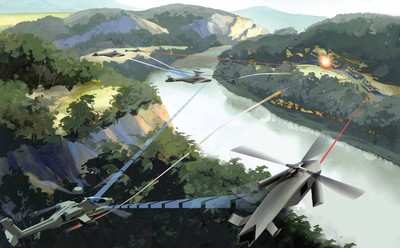Reinforces Evolving Role For UAVs in Army Operations
 Northrop Grumman Corporation
recently used two company-funded test flights of an unmanned
helicopter surrogate to demonstrate key technologies for its
proposed concept for a new US Army unmanned armed rotorcraft
program.
Northrop Grumman Corporation
recently used two company-funded test flights of an unmanned
helicopter surrogate to demonstrate key technologies for its
proposed concept for a new US Army unmanned armed rotorcraft
program.
The test flights of the company-owned Yamaha RMAX unmanned
helicopter, which is being used as a surrogate for the company's
concept for the Army's Unmanned Combat Armed Rotorcraft (UCAR)
program, included a remote-control flight and the RMAX's first
autonomous flight. The flights are the latest in a series of
company-funded activities designed to demonstrate how unmanned
systems can increase the fighting effectiveness of Army ground- and
helicopter-based units.
Northrop Grumman is currently competing for Phase III of the
UCAR demonstration program, which is funded jointly by the Defense
Advanced Research Projects Agency and the US Army. To date, the
company has conducted more than 60 flight tests of the RMAX UCAR
surrogate covering more than 35 hours of flight time to help refine
its UCAR concept.
The RMAX's first autonomous flight was completed Oct. 7 at Camp
Pendleton (CA). In that test, the air vehicle, which incorporates
vehicle management system hardware and autonomy software that
Northrop Grumman is developing for the UCAR program, was piloted
remotely to an altitude of 200 feet, then transitioned to a fully
autonomous flight. After the autonomous flight, which lasted
approximately eight minutes, the vehicle landed under remote
control. All software tests and previously predicted vehicle
responses were achieved with success.
During Army exercises conducted Sept. 9-14 at Fort Rucker (AL),
the RMAX was operated under remote control to demonstrate how
unmanned systems could reinforce the combat operations of an
advancing ground unit supported by a rotary wing aviation unit.
These company-funded flights were coupled with virtual manned and
unmanned combat units provided through modeling and simulation
activities, which included network communications.
The exercises included three scenarios, representing different
phases of a typical joint combat engagement: virtual Marine Corps
ground units advanced over desert terrain to an urban area, then
dismounted and cleared the city -- building by building. Mounted in
light armored vehicles, the Marines were supported by virtual Fire
Scout vertical take-off and landing tactical unmanned aerial
vehicles (UAVs), and simulated Marines "flying" AH-1Z Super Cobras.
The Army aviation unit also supported the virtual ground forces
using real pilots to "fly" virtual cockpits configured as AH-64D
helicopters, and Hunter UAVs simulated by systems at Redstone
Arsenal.

For these exercises, the RMAX UCAR surrogate provided real-time
video surveillance support for the virtual engagement.While the
virtual Army and Marine units "advanced," the UAV flew actual
flights at the Fort Rucker test range under remote control,
gathering video surveillance data about the "enemy" and feeding it
to the virtual troops via its mobile ground station.
"Our primary goal for the autonomous flight test at Camp
Pendleton was to demonstrate predicted autonomous vehicle response
for our UCAR concept," explained Greg Zwernemann, Northrop
Grumman's UCAR program director. "In the Fort Rucker exercise we
wanted to show that it can fly over a battle zone, collect critical
visual information, then transmit it to the ground for use by
dismounted soldiers, helicopter units or other members of a
tactical strike team."
The Fort Rucker exercises were conducted as part of the Army's
Unmanned Systems Initiative, a coordinated, Army-wide effort to
rapidly identify, evaluate, develop and integrate unmanned systems
technologies into operational systems. In addition to Army aviators
from Fort Rucker, Aviation and Missile R&D UAV system program
managers and P Executive Office tactical missile representatives
from Redstone Arsenal (AL), and dismounted combat soldiers from
Fort Benning (GA) cooperated in the exercise.
Army Col. Glen A. Rizzi (ret.), working in support of the
director of Combat Developments was enthusiastic about the Fort
Rucker tests."The Unmanned Systems Initiative allows us to
experiment with manned and unmanned systems using the latest
technology to bring live UAVs, computer simulation, and
constructive aircraft simulators from three different locations --
Fort Rucker, Redstone and Benning -- all together at one time," he
said.
 ANN's Daily Aero-Term (05.01.24): Say Altitude
ANN's Daily Aero-Term (05.01.24): Say Altitude ANN's Daily Aero-Linx (05.01.24)
ANN's Daily Aero-Linx (05.01.24) Classic Aero-TV: Korean War Hero Twice Reborn
Classic Aero-TV: Korean War Hero Twice Reborn Airborne 04.29.24: EAA B-25 Rides, Textron 2024, G700 Deliveries
Airborne 04.29.24: EAA B-25 Rides, Textron 2024, G700 Deliveries Airborne Affordable Flyers 05.02.24: Bobby Bailey, SPRG Report Cards, Skydive!
Airborne Affordable Flyers 05.02.24: Bobby Bailey, SPRG Report Cards, Skydive!




